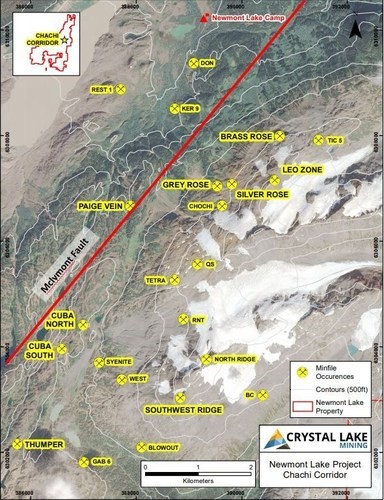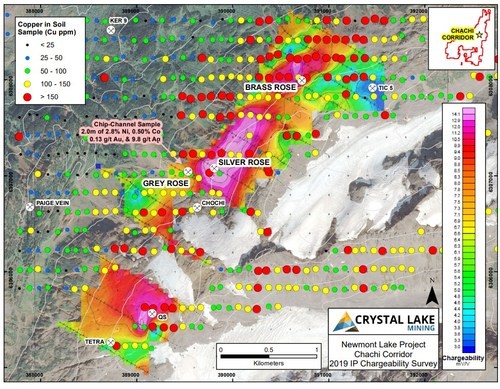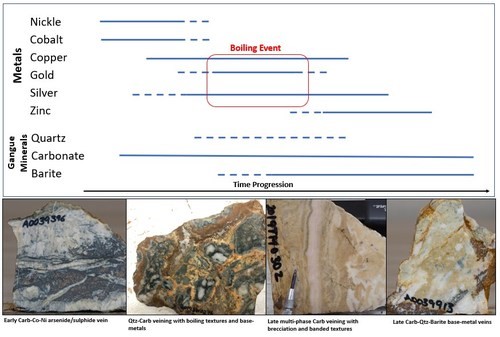
Crystal Lake Mining Announces New Discovery of Expansive, Multi-Element Hydrothermal Mineralized System at Newmont Lake, BC

Crystal Lake Mining Corporation (TSX-V: CLM) (OTC: SIOCF) (FSE: SOG-FF) is pleased to announce the discovery of a entirely new multi-element hydrothermal system in the Chachi Corridor containing high grade gold, silver, copper, nickel, cobalt, zinc and lead) mineralization spread over a massive area 8km long x 4km wide east of the Newmont Lake Gold Corridor, along the Eskay Rift, in the heart of the Golden Triangle.
At least three different styles of mineralization over the expansive area have returned assays from multiple samples, in different occurrences from surface outcrop (in-situ grab and chip samples) ranging up to 21.03 g/t Au (gold), 2,350 g/t Ag (silver), 5.4% Cu (copper), 7.7% Ni (nickel), 0.85% Co (cobalt), 15.2% Zn (zinc) and 6.2% Pb (lead). The mineralized system runs along the eastern side of the McLymont Fault and is coincident with a continuous >2km long geophysical anomaly.
Maurizio Napoli, President / CEO of Crystal Lake commented “At the start of the 2019 program on CLM’s Newmont Lake Project, the Chachi Corridor was the most underexplored area within the large land package. We carried out an extensive large maiden exploration program and what’s really exciting is that the 2019 surface exploration program has identified a new, large mineral system coincident with a 2019 >2km chargeability IP anomaly and an aeromagnetic anomaly centered on a major fault system which is associated with high grade gold mineralization in the Newmont Lake area to the southwest. Moreover, the discovery of high-grade nickel, copper, cobalt, zinc and lead was unexpected and remarkable. The 2019 program of work supports exploration for high grade Au-Cu mineralization along the Chachi corridor. The presence of high-grade VMS style and Ni-Co-Cu arsenide mineral occurrences highlights the potential for the discovery of base metal deposits along this richly endowed metal corridor.”
Discussion of 2019 Chachi Corridor Program
Multi-element soil geochemical data and rock samples from newly discovered occurrences point to a multi-element geochemical anomaly spread over an 8 km by 4 km footprint spatially associated with the fertile McLymont Fault structure including high-grade Au-Ag-Cu sulphide (gold, silver, copper sulfide), high-grade Ag-Zn-Cu-Pb (silver, zinc, copper, lead), and high-grade Ni-Co-Cu-Ag arsenide/sulphide (nickel, cobalt, copper, silver arsenide associated with stockwork copper sulfide mineralization).
A recently completed Induced Polarization (“IP”) ground geophysics survey in 2019 has detected a chargeable conductive anomaly within the soil chemical anomalies and occurrences in the footwall of the Mclymont Fault. Over 2000 soil samples, 2000 hyperspectral measurements, and 800 rock samples were collected from this area.
The results highlight a newly discovered Au-Ag-Cu occurrence, named the Leo Zone, associated with quartz veins within the footprint of a 600m long IP anomaly. Multiple samples yielded grades of 5.82–21.03g/t Au along with high-grade Ag and Cu (See assays listed below).
Exploration of the Cuba showings identified high-grade Ag-Zn-Cu-Pb sulphide mineralization associated with barite along the 3.2 km long Cuba-Thumper trend to the east of the Mclymont Fault corridor. Grades of 5-2,350g/t Ag, 15.2% Zn and up to 5.4% Cu provided reason to undertake follow-up chip-channel sampling which reproduced high concentrations of Ag, Zn, Cu, and Pb over 1.5-4.8 m wide intervals (See assays listed below).
The hydrothermal Au-Ag-Cu and Ag-Zn-Cu-Pb falls within the footprint of newly discovered high-grade Ni-Co-Cu-Au-Ag arsenide/sulphide mineralization at the brand new Brass Rose and Grey Rose occurrences containing vein-hosted and semi-massive niccolite-gersdorffite-cobaltite with grades up to 7.7% Ni (See assays listed below). Importantly, gabbroic intrusions found within the area of these occurrences are commonly associated with magmatic sulphide deposits.
These findings will underpin an aggressive exploration effort in the Chachi area that expands coverage of IP, utilizes Electro-Magnetic (“EM”) geophysics survey to locate conductive mineralization, with plans to define best targets for drilling.
Cole Evans, President / CEO of HEG commented; “The Chachi Corridor is still in its infancy of exploration, but the large 2019 program of work has identified important new mineral occurrences as well as geochemical and geophysical signatures indicative of a major mineralizing event. HEG as a services company has been fortunate to work on many good properties across the Golden Triangle in British Columbia, but Chachi is different from anything we have ever seen before. My hat is off to our entire technical team for pulling this discovery together and letting the numbers speak for themselves. This is an 8km x 4km area that had previously never received any ground geophysics, intensive prospecting, detailed mapping, hyperspectral sampling or drilling; I do not think many people would have imagined how successful the Chachi grassroots campaign would have been for Crystal Lake this season.”
Chachi Corridor Assay Highlights
Gold (Au) Silver (Ag) Copper (Cu) Assays
- “Leo” Zone – High-grade Au-Ag-Cu occurrence hosted in “bull quartz” veins +/- chalcopyrite clustered within 600m IP anomaly:
- 21.03 g/t Au, 71.56 g/t Ag, and 0.27% Cu
- 16.07 g/t Au, 30.40 g/t Ag, and 0.13% Cu
- 13.39 g/t Au, 156.00 g/t Ag, and 0.75% Cu
- 11.13 g/t Au, 31.73 g/t Ag, and 0.006% Cu
- 10.96 g/t Au, 45.41 g/t Ag, and 0.062% Cu
- 10.68 g/t Au, 112.00 g/t Ag, and 0.049% Cu
- 9.40 g/t Au, 64.94 g/t Ag, and 0.016% Cu
- 7.97 g/t Au, 25.4 g/t Ag, and 1.66% Cu
- 5.82 g/t Au, 60.05 g/t Ag, and 0.17% Cu
- The “Rose Series” of showings also demonstrates high-grade Cu-Au-Ag mineralization:
- 6.57% Cu, 0.28 g/t Au, and 20.96 g/t Ag
- 5.36% Cu, 0.01 g/t Au, and 35.82 g/t Ag
- 4.57% Cu, 0.44 g/t Au, and 11.29 g/t Ag
- 4.12% Cu, 0.02 g/t Au, and 1.49 g/t Ag
- 3.97% Cu, 0.19 g/t Au, and 2.74 g/t Ag
- 2.98% Cu, 0.18 g/t Au, and 17.18 g/t Ag
- 2.78% Cu, 0.13 g/t Au, and 1.16 g/t Ag
- 2.74% Cu, 0.03 g/t Au, and 301.00 g/t Ag
- 2.53% Cu, 0.32 g/t Au, and 736.00 g/t Ag
- 2.46% Cu, 0.24 g/t Au, and 5.91 g/t Ag
- 2.19% Cu, 0.03 g/t Au, and 112.00 g/t Ag
- 2.11% Cu, 0.33 g/t Au, and 7.54 g/t Ag
- 2.06% Cu, 0.01 g/t Au, and 603.00 g/t Ag
- 2.00% Cu, 0.03 g/t Au, and 179.00 g/t Ag
- 1.88% Cu, 0.02 g/t Au, and 172.00 g/t Ag
- 1.77% Cu, 0.34 g/t Au, and 224.00 g/t Ag
- 1.62% Cu, 1.61 g/t Au, and 22.12 g/t Ag
Silver (Ag) Zinc (Zn) Copper (Cu) Lead (Pb) Assays
- Extended “Cuba-Tetra-Thumper” trend – High-grade Ag-Zn-Cu-Pb barite system sampled and mapped over ~2.5km strike parallel to the Mclymont Fault system:
- 2,350 g/t Ag, 15.20% Zn, 1.30% Cu, and 0.59% Pb
- 2,338 g/t Ag, 12.90% Zn, 1.60% Cu, and 0.16% Pb
- 1,022 g/t Ag, 7.10% Zn, 0.30% Cu, and 0.69% Pb
- 854 g/t Ag, 4.30% Zn, 5.40% Cu, and 1.53% Pb
- 833 g/t Ag, 11.71% Zn, 0.22% Cu, and 1.24% Pb
- 775 g/t Ag, 5.9% Zn, 0.74% Cu, and 0.075% Pb
- 473 g/t Ag, 10.4% Zn, 0.18% Cu, and 0.013% Pb
- 451 g/t Ag, 7.80% Zn, 0.23% Cu, and 0.073% Pb
- 285 g/t Ag, 2.84% Zn, 0.23% Cu, and 0.034% Pb
- 269 g/t Ag, 2.00% Zn, 0.12% Cu, and 0.020% Pb
- 242 g/t Ag, 1.55% Zn, 0.15% Cu, and 0.007% Pb
- 242 g/t Ag, 12.92% Zn, 0.11% Cu, and 0.009% Pb
- 107 g/t Ag, 13.31% Zn, 0.048% Cu, and 4.43% Pb
- 12.44 g/t Ag, 12.04% Zn, 0.032% Cu, and 1.24% Pb
- 28.2 g/t Ag, 8.34% Zn, 0.016% Cu, and 0.002% Pb
- 88.32 g/t Ag, 6.90% Zn, 0.082% Cu, and 0.003% Pb
- 57.84 g/t Ag, 5.61% Zn, 0.043% Cu, and 10.6% Pb
- 4.56 g/t Ag, 5.52% Zn, 0.007% Cu, and 0.24% Pb
- Follow-up chip-channel sampling (not continuous) along several outcrops over ~200m trend of “Cuba-Tetra-Thumper” returned:
- 2.4 metres of 1,071 g/t Ag, 9.30% Zn, 0.37% Cu, and 2.0% Pb on surface.
- 4.8 metres of 728 g/t Ag, 7.70% Zn, 0.19% Cu, and 6.2% Pb on surface.
- 1.5 metres of 359 g/t Ag, 10.0% Zn, 0.17% Cu, and 0.018% Pb on surface.
- 3.0 metres of 296 g/t Ag, 7.0% Zn, 0.12% Cu, and 0.022% Pb on surface.
- 3.0 metres of 232 g/t Ag, 3.9% Zn, 0.039% Cu, and 0.55% Pb on surface.
- 1.5 metres of 224 g/t Ag, 2.3% Zn, 0.070% Cu, and 0.66% Pb on surface.
- 2.5 metres of 129 g/t Ag, 4.99% Zn, 0.09% Cu, and 2.05% Pb on surface.
- 2.0 metres of 67.82 /t Ag, 4.59% Zn, 0.064% Cu, and 0.006% Pb on surface.
- 1.5 metres of 85.27 g/t Ag, 3.27% Zn, 0.041% Cu, and 0.25% Pb on surface.
Nickel (Ni) Cobalt (Co) Copper (Cu) Silver (Ag) Assays
- “Brass Rose” showing – High-grade Ni-Co-Cu-Ag arsenide/sulphide occurrence:
- 7.7% Ni, 0.85% Co, 0.17% Cu, and 10.9 g/t Ag
- “Grey Rose” showing ~1.5km from “Brass Rose” discovered multiple outcrop samples of various vein generations including:
- 3.2% Ni, 0.57% Co, 1.3 g/t Au, and 1.5 g/t Ag
- 2.4% Ni, 0.34% Co, 0.2 g/t Au, 21.2 g/t Ag, and 0.13% Cu
- 0.86% Ni, 0.19% Co, 0.02 g/t Au, and 2.69 g/t Ag
- 0.58% Ni, 0.10% Co, 0.11 g/t Au, and 4.74 g/t Ag
- 0.12% Ni, 0.08% Co, 0.01 g/t Au, and 18.72 g/t Ag
- Follow-up chip-channel sampling (not continuous) along the same outcrop of “Grey Rose” Ni-Co returned:
- 2.0 metres of 2.8% Ni, 0.50% Co, 0.13 g/t Au, and 9.8 g/t Ag on surface.
- 2.0 metres of 0.58% Ni, 0.11% Co, 0.11 g/t Au, 4.74 g/t Ag, and 0.16% Zn on surface.
- 2.0 metres of 0.61% Cu, 0.04% Co, 79.53 g/t Ag, and 0.66% Zn on surface.
- There is a general Ni-Co enrichment across a wide range of samples throughout the Chachi Corridor proximal to the IP conductivity/chargeability feature.
Photo / Map Gallery
Cautionary Statement of Photo Gallery:
Please note the visualizations are selected images highlighting strong visual mineralization from a variety of new showings and recent diamond drill core. Mineral identification has been determined visually by geologists and cross-referenced via mobile X-ray Fluorescence elemental geochemical techniques (ThermoScientific Niton XL5 pXRF). Portable XRF data is not provided as it is not an indicator of representative geochemistry of the entire rock mass. The reader should also note that while relative spatial information is provided, mineralization is not necessary representative of space between any given location and it should not be assumed that lateral continuity exists. The reader is encouraged to exercise caution, due their due diligence, and determine their own conclusions with the information provided.
Qualified Person
The technical information in this news release has been reviewed and approved by Mr. Maurizio Napoli, P. Geo., CEO/President for Crystal Lake Mining, a Qualified Person responsible for the scientific and technical information contained herein under National Instrument 43-101 standards.
QAQC/ Analytical Procedures
Rock Samples
Rock samples from the Newmont Lake Project were sent to MSALABS’ preparation facility in Terrace, B.C., where samples were pulverized to 85% passing 75 microns. Prepped samples were sent to MSALABS’ analytical facility in Langley, B.C., where 50g pulps were analyzed for gold using method FAS-121 (fire assay-AAS finish). Gold assays greater than 100 g/t Au were automatically analyzed using FAS-425 (fire assay with a gravimetric finish). Rock samples were analyzed for 53 elements using method IMS-230, multi-element ICP-MS 4-acid digestion, ultra-trace level. Silver assay results greater than 100 g/t Ag and cobalt, copper, nickel, lead and zinc greater than 10,000ppm were automatically analyzed by ore grade method ICF-6.
Crystal Lake Mining conducts its own QA/QC program where three standard reference material pulps, two blank reference material samples are inserted for every 100 samples when analyzing rock samples.
Soil Samples
Soil samples from the Newmont Lake Project were sent to MSALABS’ preparation facility in Terrace, B.C., where samples were prepared using method PRP-757. Soil samples were dried and screen to 80 mesh, discard plus fraction. Prepped samples were sent to MSALABS’ analytical facility in Langley, B.C., where they were analyzed for 51 elements using IMS-131 for samples with 20g or greater and IMS-130 for samples between 0.5g and 20g.
Crystal Lake Mining conducts its own QA/QC program where three standard reference material pulps, two blank reference material pulps are inserted for every 100 samples when analyzing soil samples.
About Crystal Lake Mining
Crystal Lake Mining is a Canadian-based junior exploration company focused on building shareholder value through high-grade discovery opportunities in British Columbia and Ontario. The Company has an option to earn a 100% interest in the Newmont Lake Project, one of the largest land packages among juniors in the broader Eskay region in the heart of Northwest B.C.’s Golden Triangle.

Location of new and historic showings within the Chachi Corridor. (CNW Group/Crystal Lake Mining Corporation)

Distribution of Ni-Co-Cu-Au-Ag-Zn mineralization throughout the Chachi Corridor. (CNW Group/Crystal Lake Mining Corporation)

The N5 slide of the 2019 IP survey shows a chargeable response coincident with sizable Cu in soil anomaly with the newly discovered Grey Rose, Silver Rose and Brass Rose showings centered along the chargeable feature. (CNW Group/Crystal Lake Mining Corporation)

Interpreted paragenesis of the multi-stage veining system within the Chachi Corridor. (CNW Group/Crystal Lake Mining Corporation)

Representative sample B0003611 assaying 7.7% Ni, 0.85% Co, 0.17% Cu, and 10.9 g/t Ag with additional rep. samples for the showing in the background. (CNW Group/Crystal Lake Mining Corporation)

Representative sample of massive sulphides (pyrrhotite, pyrite with minor chalcopyrite) in contact with high-grade Ni-Co arsenides. Rep. sample assayed 0.20% Cu. (CNW Group/Crystal Lake Mining Corporation)

Newly discovered gabbroic mafic intrusive rocks within the Chachi Corridor. This rock type is highly unusual for the region and is often associated with Ni-Cu-Co deposits around the world. (CNW Group/Crystal Lake Mining Corporation)
MORE or "UNCATEGORIZED"
Koryx Copper Intersects 338.61 Meters At 0.38% Cu Eq Including 230.61 Meters At 0.45% Cu Eq and Multiple 2 Meters Intersections Over 1.00% Cu Eq
Significant copper and molybdenum intersections include: HM09: 13... READ MORE
Aya Gold & Silver Reports Q1-2024 Results; Maintains Guidance; Zgounder Expansion on Track
Aya Gold & Silver Inc. (TSX: AYA) (OTCQX: AYASF) is pleased t... READ MORE
Silver Mountain Delivers Positive Preliminary Economic Assessment For Its Reliquias Project, Peru; Pre-Tax NPV 5% Of C$107 million, Pre-Tax IRR Of 57%, And Payback Of 1.8 Years
Key Highlights – Preliminary Economic Assessment Pre-Tax Net Pr... READ MORE
ARIS MINING REPORTS Q1 2024 RESULTS WITH SEGOVIA GENERATING $13.8 MILLION IN OPERATING CASH FLOW
Aris Mining Corporation (TSX: ARIS) (NYSE-A: ARMN) announces its ... READ MORE
Orla Mining Reports First Quarter 2024 Results
Orla Mining Ltd. (TSX: OLA) (NYSE: ORLA) announces the results fo... READ MORE










